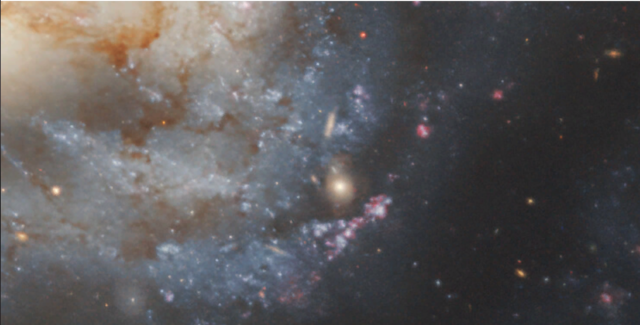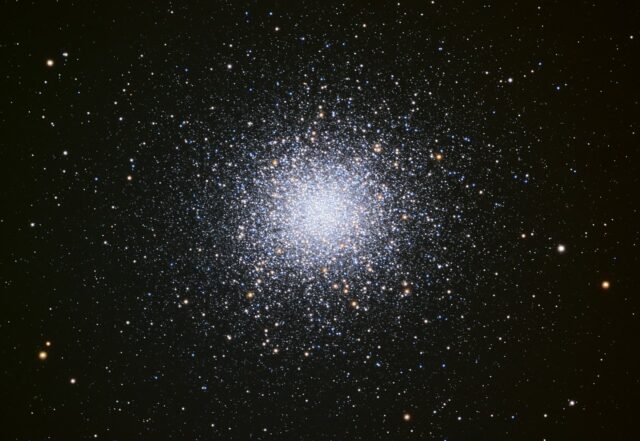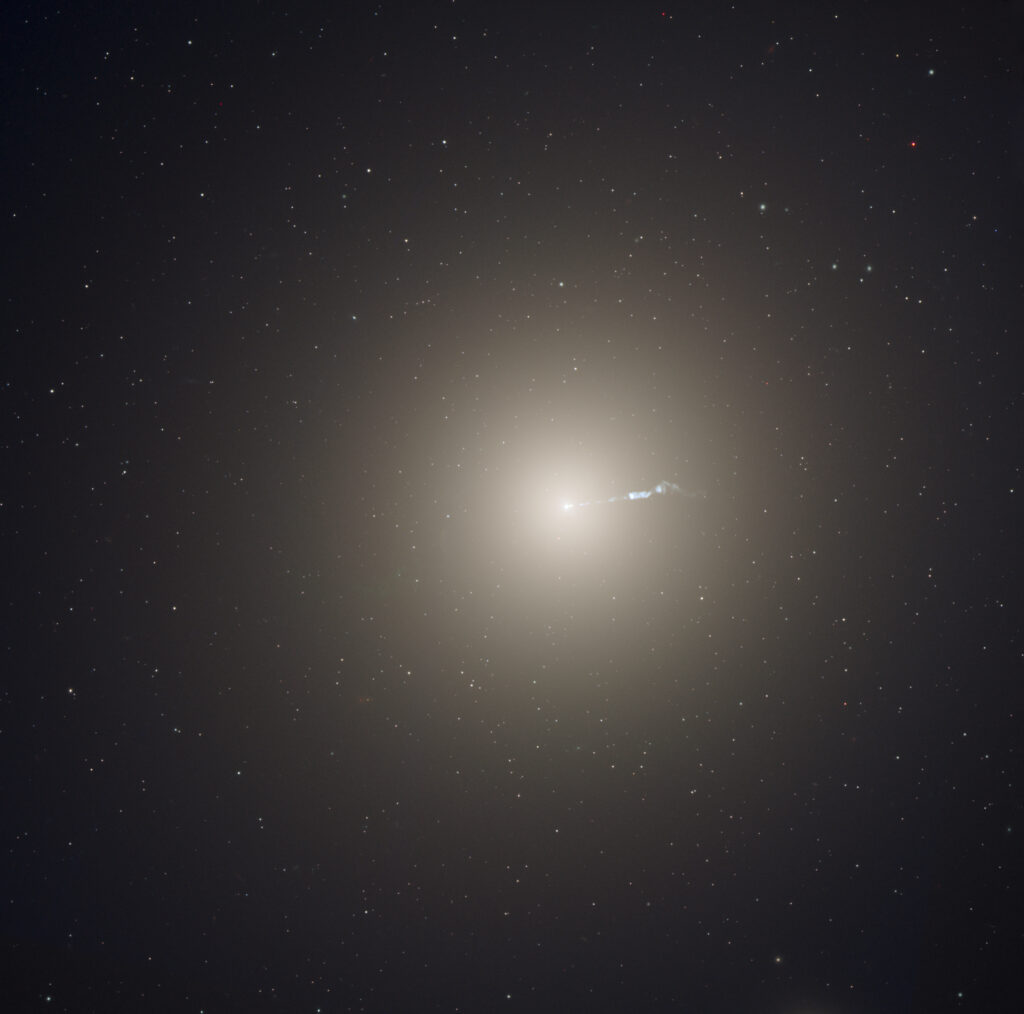The southern extent of NGC-1365 showing the galaxy’s active galactic nucleus at the bottom left. A plethora of background galaxies are visible, with one prominent elliptical galaxy to the southwest (upper right) amid the other edge-on galaxies. Appearing as a small bright sphere, this galaxy is 2.9 billion light-years distant or 52x more distant than NGC-1365 in the foreground. Image data, NASA/STSci.edu, image processing, James Daly, Ph.D.
On August 27, we published a comprehensive article about one of NASA’s Early Release Observation (ERO) program targets for JWST (attribution at the foot of this page).
Known as “The Great Barred Spiral Galaxy“, NGC-1365 is a Barred-spiral galaxy 55 million light-years distant in the southern constellation Fornax and a member of the Fornax cluster of galaxies. We see the galaxy today as it was 55 million year ago, 10 million years after the dinosaurs went extinct!
While making reference to the NGC-1365 as appropriate, we’ll focus on a detail that may have gone unnoticed, a detail hiding in plain sight. Taking advantage of the remarkable resolving power of JWST, ancient relics surrounding a massive background galaxy are revealed in plain sight.
Why is this galaxy so bright (in the Infrared)?
Visible light image of the same area below, obtained with the Víctor M. Blanco 4-meter Telescope at Cerro Tololo Inter-American Observatory. Our galaxy of interest is located at the center as a spherical, background object 2.9 billion light-years distant. Notice the distinct coloration of the galaxy, the same coloration as the nucleus of NGC-1365. This warm hue is indicative of older, evolved population II stars, stars that are evolving towards giants and supergiants. As they expand, they cool becoming redder and thus take on this characteristic warm hue, they collectively appear as such when compared to bluer regions indicative of new star formation. As is the case with Elliptical galaxies, no new stars form in the nuclear regions.
That the top image from JWST features this galaxy as very bright is not surprising. We must remember that image is in the Infrared. The image we see is in the infrared and thus, the cooler, evolved stars of the background elliptical galaxy will emit much of their radiant energy in the Infrared, hence the apparent “brightness” of the galaxy. Compare that with the optical image below.

Visible light image of the same area, showing the galaxy of interest as a spherical, background object with the same hue and coloration as the nuclear region of NGC-1365 to the upper-left corner.
Elliptical Galaxies
Most elliptical galaxies are bereft of any gas or dust and thus, no new stars can form. Having depleted the raw-material of new-star formation, hydrogen gas and dust, all stars that will ever form in these galaxies have already formed. They’re generally quite massive with their stars simply running out their evolutionary clocks. These galaxies are populated with ancient, stellar relics, stars much older than the sun, aged between 7 – 10 billion years. For the lower-mass stars, these would be some of the first stars to ever form, for the more massive stars, 2nd or 3rd generation. First generation stars are the first stars that ever formed. One stellar generation is the complete life-cycle of a star, from birth through death – our sun is a 3rd generation star, having formed 9 billion years after the big bang.
Globular Star Clusters

The famous globular star cluster Messier-13 (M13), 22,000 light-years distant in the constellation Hercules. Image credit: RCOS 24-inch telescope at the Mount Lemmon SkyCenter.
Globular star clusters are large, generally spherical agglomerations of stars between 100,000 to 1/2 million associated with most large galaxies. Our galaxy, the Milky Way, contains a few hundred orbiting the galaxy outside the galactic bulge, also known as the “Halo“. Compare that to the giant elliptical galaxy M-87 (featured below) that contains over 15,000 globular clusters.
The stellar populations of globular clusters formed at the same time and from the same cloud of gas, and therefore constitute a ‘single stellar population’. With this simplicity in their stellar population and the proximity of the ~150 known globular clusters in the Milky Way, they are used as models to test our understanding of stellar evolution.
Among those stellar populations are evolved, red-giant stars, some of the oldest stars in the universe, stars similar in age and luminosity to the beautiful, ruby-red Arcturus, visible most of the year in the Northern Hemisphere.
Ancient Relics Surrounding Background Elliptical Galaxy
Close to the limit of detection by JWST at magnitude 31.2, globular clusters surround this background elliptical galaxy at 2.9 billion light-years. Similar to the stars that populate elliptical galaxies, globular star clusters contain some of the oldest stars in the universe. Some of them are evolved red giant stars like the beautiful ruby-red Arcturus, visible for most of the year in the Northern Hemisphere.

Background elliptical galaxy 2.9 billion light-years distant with myriad globular star clusters surrounding it like moths to a flame.
Consistent with the aged stellar population of elliptical galaxies are their associated globular clusters. Like the stellar populations of elliptical galaxies, globular clusters contain some of the oldest stars in the universe.
Distance Determination of Background Galaxy
Determination of this galaxy’s distance of 2.9 billion light-years was first determined using geometric size comparison techniques. This distance was confirmed using known photometric values and absolute magnitudes of globular clusters. The average apparent magnitude of the globular clusters surrounding the galaxy were 31.2, almost 3 magnitudes brighter than JWST’s limiting magnitude of 34.
M-87
First image
HST visible light image of the giant elliptical galaxy M87 (Messier-87) in Virgo. In this image we clearly see the relativistic jet emanating from its massive, central black hole and the myriad globular star clusters (about 15,000) surrounding it as moths to a flame. At 54 million light-years, a distance coincidentally the same as NGC-1365, M-87 is much closer. It was recently made famous with the imaging of its central black hole’s event horizon by the EHT (Event Horizon Telescope).

HST visible light image of M87 in Virgo showing the relativistic jet emanating from its massive, central black hole and the myriad globular star clusters (about 15000) surrounding its nuclear region.
Second image
Wider-field view using a 0.5 meter professional, ground-based telescope clearly showing the myriad globular clusters surrounding the galaxy. M-87 and its swarm of globular clusters are not unlike the distant, background galaxy with its globular clusters featured above.

Visible light image of M87 in Virgo showing the myriad globular star clusters (about 15,000). Image credit: Robert Gendler.
Attribution
”The Early Release Observations and associated materials were developed, executed, and compiled by the ERO production team: Hannah Braun, Claire Blome, Matthew Brown, Margaret Carruthers, Dan Coe, Joseph DePasquale, Nestor Espinoza, Macarena Garcia Marin, Karl Gordon, Alaina Henry, Leah Hustak, Andi James, Ann Jenkins, Anton Koekemoer, Stephanie LaMassa, David Law, Alexandra Lockwood, Amaya Moro-Martin, Susan Mullally, Alyssa Pagan, Dani Player, Klaus Pontoppidan, Charles Proffitt, Christine Pulliam, Leah Ramsay, Swara Ravindranath, Neill Reid, Massimo Robberto, Elena Sabbi, Leonardo Ubeda. The EROs were also made possible by the foundational efforts and support from the JWST instruments, STScI planning and scheduling, and Data Management teams.”
Astronomy For Change: https://astronomyforchange.org
Did you enjoy this article or like what we do? Why not leave a tip or buy us a Coffee?
Follow Us On Twitter: https://twitter.com/astronomychange
Why not support us on Patreon: https://www.patreon.com/astronomyforchange
Imagination is more important than knowledge
![]()
An index of all articles can be found here.
If you enjoyed this article, please consider supporting us with a modest donation
or through a subscription on our Patreon Page
Membership at Astronomy for Change is Free!




